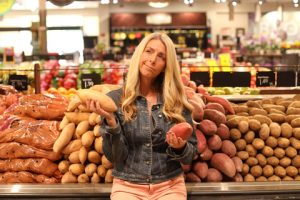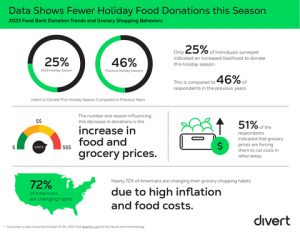Yam or Sweetpotato? Sweetpotato or Sweet Potato? Answers Here
 It happens every Thanksgiving. You head to the grocery store to shop for the big day. Of course, you’ll need to buy yams for the family’s favorite casserole. But when you get to the produce department, the display sign says “sweetpotato.” Or perhaps some are labeled as “yams” and others are “sweetpotatoes.” Which should you buy? And what’s the difference between a sweetpotato and a yam anyway?
It happens every Thanksgiving. You head to the grocery store to shop for the big day. Of course, you’ll need to buy yams for the family’s favorite casserole. But when you get to the produce department, the display sign says “sweetpotato.” Or perhaps some are labeled as “yams” and others are “sweetpotatoes.” Which should you buy? And what’s the difference between a sweetpotato and a yam anyway?
This Thanksgiving, California sweetpotato farmers are on a mission to end this confusion once and for all. Their message is really very simple: Yam = Sweetpotato
“Sweetpotatoes come in all kinds of colors – red, orange, white, and, even purple. You may see them labeled as yams in the grocery store, but they’re actually sweetpotatoes,” explains Sarah Alvernaz, who farms sweetpotatoes in the heart of California’s sweetpotato growing region.
Alvernaz and other California growers who make up the California Sweetpotato Council are working to educate consumers and put an end to all the confusion about sweetpotatoes versus yams, particularly for younger consumers who may not be interested in eating yams but have heard that sweetpotatoes are a superfood.
“True yams are very different from sweetpotatoes and are a starchy, tuberous vegetable mostly grown in Africa,” explains Alvernaz. “You are unlikely to find true yams at a U.S. supermarket, despite what you might see on display signs.”
Unlike yams, sweetpotatoes are native to the Americas. The United States produces approximately 1.7 million tons of sweetpotatoes each year. California is the second largest producing state for sweetpotatoes because the warm dry climate and sandy soils of California’s Central Valley provide the optimum growing environment for quality roots. Some 90 percent of California’s sweetpotatoes are grown within a 20-mile radius of the small town of Livingston and the remaining 10 percent are grown near Bakersfield.
Alvernaz also explains that it’s common to see some sweetpotatoes at your grocery store labeled by varietal names such as Covington, Garnet or Jewell. But growers actually produce dozens of different varieties.
“We’re encouraging retailers to label sweetpotatoes according to color,” notes Alvernaz. “Most varieties we grow can be accurately categorized as either red, orange, white or purple sweetpotatoes. All four types have similar cooking times and can be used pretty much interchangeably in recipes.”
“We just want people to know that sweetpotato is a modern, more accurate term than yam,” says Alvernaz. “Even if they’re labeled as yams in the store, they are sweetpotatoes! Whether they’re red, orange, white or purple – all can be used in any recipe that calls for yams. Sweetpotatoes are a versatile, delicious superfood available every day of the year.”
To help support this message, the California Sweetpotato Council is working with retailers to correctly label sweetpotatoes in their stores. Shoppers can find simplified, updated information about sweetpotatoes here.
“Rest assured the Thanksgiving yam dish that’s been in your family for generations has always been made with sweetpotatoes,” says Alvernaz. “Probably with red or orange varieties but go ahead and buy whatever color you find in your store. And don’t forget that sweetpotatoes can be used in a variety of recipes not just for the holidays.”
Alvernaz adds that sweetpotatoes are, in fact, a superfood with each containing over 80 nutrients. They’re high in vitamin B6, vitamin A, carotene, and potassium, they’re rich in antioxidant vitamins C and E and are a great source of manganese and dietary fiber.
More information about sweetpotato nutrition, cooking facts and delicious recipes can be found at the California Sweetpotato Council website here.
For the record, the council says it’s sweetpotato, not sweet potato: On this one we admit there’s not a lot of agreement. But we believe that “sweetpotato” is correct because our product is not, in fact, a sweet potato. It’s not a potato at all, but botanically an entirely different vegetable, gifted with a totally different set of better-for-you nutrients, amazing taste, and incredible versatility. So sweetpotatoes—one word—is not only grammatically correct, but it helps make the distinction.
For more news of interest to the specialty food industry, subscribe to Gourmet News.
Holiday Food Donations Expected to Decrease, Survey Says
 Divert, Inc. announced new data from a consumer survey and analysis on food bank donations, food insecurity and grocery shopping behaviors. The survey found that high inflation and grocery prices are having a significant impact on consumers’ food donations during the holiday season, as well as their grocery shopping habits and preferences.
Divert, Inc. announced new data from a consumer survey and analysis on food bank donations, food insecurity and grocery shopping behaviors. The survey found that high inflation and grocery prices are having a significant impact on consumers’ food donations during the holiday season, as well as their grocery shopping habits and preferences.
The United States throws away more than 63 million tons of wasted food each year. Couple this with recent research released by the U.S. Department of Agriculture on the state of household food security showing that the hunger problem is growing rapidly. In 2022, 17 million households reported being food insecure – significantly higher than both 2021 (13.5 million households) and 2020 (13.8 million households).
With this backdrop, Divert commissioned this survey to better understand how the current economic climate is affecting U.S. food banks and food security in the wake of the COVID-19 pandemic, especially as we enter the critical holiday season.
“Preventing waste through food donations to help feed people in need is central to our mission,” said Ryan Begin, CEO and co-founder, Divert. “Since 2018, we have worked with our customers to facilitate the donation of more than 12.5 million pounds of food, equivalent to nearly 10.5 million meals. With this survey and our analysis, we want to shed light on the state of food donations and consumer shopping habits so that we can help drive education, understanding, and real change.”
Grocery Prices Impacting Consumer Food Donations
Nearly half (46 percent) of respondents said they are more likely to donate to food banks during the holiday season than at other times of the year. Yet, with the 2023 holiday season approaching – in which demand for food banks is expected to surge – only 25 percent of respondents said they are more likely to donate during this year’s holiday season compared to years past. Those who are donating less to food banks this season cite increasing food and grocery costs as the number one reason driving their decision.
This behavior is emerging despite overwhelming knowledge among respondents that food insecurity is a growing concern – with 85% believing that food insecurity levels have increased since the COVID-19 pandemic and 63 percent believing that the United States is significantly more food insecure (16+ percent) than the latest USDA data shows (12+ percent). The majority of survey respondents (64 percent) have donated food or money to food banks in the last year, citing the increasing awareness of food insecurity as a key reason influencing their decision to donate more.
Other key findings:
- 24 percent of respondents typically donate to food banks once a quarter, 33 percent typically donate once a year, and 33 percent typically donate every couple of years
- Respondents donating more to food banks are doing so because of growing awareness of food insecurity (75 percent) followed by a passion for giving back (48 percent)
Changing Grocery Shopping Habits
The current economic climate is also having a significant impact on consumers’ behaviors, with nearly 72 percent of Americans changing their grocery shopping habits due to high inflation and food costs. More than half of respondents (51 percent) indicated that grocery prices are forcing them to cut costs in other areas.
The survey found that 25 percent of consumers are more anxious about their ability to afford food in the next three to six months and 30 percent are purchasing less fresh food like produce due to the skyrocketing price of groceries.
Other key findings on how consumers’ grocery shopping behaviors have changed in the past year:
- 76 percent of households are shopping for more discounted food
- 58 percent of households are shopping at less expensive food retailers
- 42 percent of respondents are shopping for less food at a time
- 17 percent of households are eating more food past its prime
- 63 percent of respondents said they are throwing away more food than they would like
For the full survey results and methodology, please click here.
Divert, Inc. is an impact technology company on a mission to Protect the Value of Food. Founded in 2007, the company creates advanced technologies and sustainable infrastructure to eliminate wasted food, driving social and environmental impact. Divert provides an end-to-end solution that prevents waste by maximizing the freshness of food, recovers edible food to serve communities in need, and converts wasted food into renewable energy. The company works with five Fortune 100 companies and nearly 5,400 retail stores across the U.S., helping food retailers to reach their sustainability goals.
For more news of interest to the food and beverage industry, subscribe to Gourmet News.
SEG Mobile Food Pantry to Distribute 70K Turkeys to Families

Southeastern Grocers Inc.is holding more than 20 mobile food pantry events to distribute over 7,000 turkeys to families and individuals experiencing hunger. (Photo: Business Wire)
Southeastern Grocers Inc., parent company and home of Fresco y Más, Harveys Supermarket and Winn-Dixie grocery stores, together with the SEG Gives Foundation, is giving back to its communities facing food insecurity ahead of the Thanksgiving holiday by supporting more than 20 mobile food pantry events to distribute over 7,000 turkeys to families and individuals experiencing hunger. To further its commitment to alleviating hunger in the Southeastern communities it serves, SEG is also launching its annual in-store community donation program benefiting Feeding America – the nation’s largest hunger-relief organization.
The mobile food pantry events are designed to reach communities where the need is most significant, including in its hometown of Jacksonville, the Florida Panhandle, Central Florida, South and Southwest Florida, the New Orleans and Acadiana area and the greater Birmingham, Ala., area. SEG recognizes the importance of coming together during the holiday season and is eager to help families get access to the food they need to enjoy a festive meal together.
Raymond Rhee, chief people officer of Southeastern Grocers, said,“We believe in the spirit of giving and the transformative power of gratitude. This is the season to give thanks, and we are honored to share the abundance of the season by distributing turkeys and Thanksgiving meal essentials to families in need. By helping provide nourishment to our neighbors facing food insecurity, we are also fostering a sense of community and togetherness as we embrace the true meaning of the season. Through our ongoing commitment to giving back, we invite our valued customers to join us on this journey as we launch our holiday hunger relief donation program benefiting our long-standing partner Feeding America. Together, we can make this holiday season a special time for all.”
More than 44 million people, including over 13 million children, live in food insecure households, according to Feeding America. To help ensure no one in its communities goes without a warm meal this Thanksgiving, SEG is supporting mobile food pantry events organized by Feeding America partner food banks, including Feeding Northeast Florida, Feeding Tampa Bay, Feeding the Gulf Coast, Feeding South Florida, Second Harvest Food Bank of Central Florida, Second Harvest Food Bank of Greater New Orleans and Acadiana, as well as local nonprofit and military organizations. Community members facing hardship are encouraged to reach out to their local food bank for more information regarding the distribution events and to explore additional resources for sustained assistance.
In the spirit of giving, and to broaden its support during the holidays, SEG is activating its annual holiday hunger relief program to help raise funds and awareness for food insecurity. Now through Dec. 19, Fresco y Más, Harveys Supermarket and Winn-Dixie customers can help their neighbors in need this holiday season by donating $1, $5 or rounding up their grocery bill. Every cent raised will support Feeding America and partner food banks throughout Alabama, Florida, Georgia, Louisiana and Mississippi.
To help customers stuff their carts with savings this holiday season, Winn-Dixie is offering a “Thanks-Winning” holiday meal for under $30,1 providing customers with a traditional Thanksgiving feast, including a 15-pound or less frozen Butterball turkey and SE Grocers sides. The grocer is providing additional savings opportunities by holding down the price on grocery staples with its brand-new seasonal discount program. Winn-Dixie’s new “Price Hold” program lowers prices on more than 1,000 commonly shopped items to help customers stretch their grocery budget more than ever before. Customers can save over 20%2 on average when shopping items marked in blue Price Hold signage throughout Winn-Dixie stores.
In appreciation of the grocer’s associates, all Fresco y Más, Harveys Supermarket and Winn-Dixie stores will be closed on Thanksgiving Day to give associates a well-deserved day of rest with family and friends. All stores will close as normal Wednesday, Nov. 22 and reopen for regular business hours Friday, Nov. 24.
For more news of interest to the grocery industry, subscribe to Gourmet News.